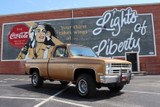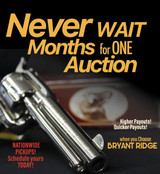Sunday Showcase Recap
Recap on The 8/11 Sunday Showcase


Following World War II...Colt was one of the first gun companies to begin making guns using new "Space Age" materials like aluminum. Colt's first entry in the field was with the aluminum framed Colt Commander automatic of 1949. Their second entry was with an aluminum frame version of the Detective Special. Colt called this aluminum alloy "Coltalloy". This new model was named the Colt Cobra. This was the first time Colt named a gun after a snake, and led to a series of "Snake" named pistols made by Colt. It was just the Detective Special with an aluminum frame, side plate, and cylinder crane. The barrel and all other parts were made of steel. It was produced from 1950 to 1981. Over the years, the Cobra was offered in barrel lengths of 2 inches, 3 inches, and 4 inches. There were a few rare 5 inch square butt models made for the Venezuelan government. Calibers were .38 Special, .32 New Police (.32 S&W), .38 New Police (.38 S&W), and .22LR. Finishes were bright blued steel parts with blue-black anodized aluminum parts, or in full bright nickel.
The Second Issue Cobra. Made from 1973 to 1981. It was offered in bright blue, and bright nickel. Some Cobras may have been made with a satin Electroless nickel finish, also known as "Coltguard". During the Colt strike, Cobras were offered with an unpolished matte black finish. This new style Cobra had a heavy barrel that shrouded the ejector rod and a long ramp front sight. The new design included walnut combat-type grips that enclosed the front and bottom of the grip frame. These post-1972 Cobras were the only version that Colt ever rated for use with +P ammunition. The gun was rated for "up to" 1000 rounds of +P ammunition, at which point the gun was to be returned to Colt for inspection and possible frame replacement.


Smith & Wesson’s dominance in the .357 Mag. market changed forever in 1955; however, when Colt introduced its first revolver chambered in .357 Mag: the Python. By all accounts, Colt executives also considered this to be the finest revolver the company produced at the time. No expense was spared in the manufacturing process, from the revolver’s timing and lock-up to its Royal Blue finish, this would be the pinnacle of Colt’s manufacturing prowess and remains—to this day—one of the finest revolvers ever made, no matter the caliber. Originally, it was introduced in Colt’s spectacular Royal Blue finish with a 6-inch-barrel length. Most folks will tell you that a vent rib on a gun barrel is for heat dispensation to maintain accuracy without being thrown off by the wiggly, mirage-like blurriness caused by excessive heat rising off the barrel. That all makes sense, but the designer of the Python, Al Gunther, stated that the vents were primarily there to reduce the gun's weight. The gun originally had a hollow barrel lug also to reduce weight, but it still came in at 43 ounces. Eventually, the barrel lugs were made solid to add weight to the gun at the barrel end. Subsequently, the Python was offered in 2.5-, 3-, 4-, 6- and 8-inch barrel lengths, and some 8-inch Pythons came factory equipped with a hunting scope, making the Python the first revolver to be equipped—out of the box—ready for hunting. The incorporation of Colt Accro and Elliason rear sights allowed the gun to be zeroed for both windage and elevation. The oil-finished, checkered American walnut grips with the gold Colt medallion rounded out the presentation that came with a whopping $125 price tag—almost double the MSRP of Colt’s Trooper model. Demands were made for other finishes besides Royal Blue, so over the years, Colt offered the Python in Bright Nickel, satin electroless nickel known as "Coltguard," and in the early 1980s in satin stainless steel, and in bright mirror polished stainless steel, variously known as Bright Polish or Ultimate Polish. Between 1955, when it was introduced, and 1997, when production ceased for the first-generation Python, more than 750,000 were produced. Manufactured in 1988, this revolver with serial number T74725 is documented as a .357 Magnum Combat Python model with a three-inch barrel, blue finish, and checkered walnut service stocks. This revolver is one of only 500 Combat Pythons produced exclusively for Lew Horton Distributing Company. It features a special roll mark reading "COMBAT PYTHON/357 MAGNUM CTG." on the left side of the barrel, alongside standard markings and features.


Smith & Wesson's first venture into the semi-auto pistol field consisted of a design based on the Belgium-made Clement pistols. Initial production was for a S&W proprietary cartridge, the .35 S&W Auto. A .32 ACP version followed this. The Smith & Wesson .32 semi-automatic pistol Model of 1924 represents an innovative engineering effort to utilize more standardized ammunition and enhance its aesthetic appeal. Originating as an improvement upon the earlier Model 35, this variant features notable upgrades such as a finger safety located under the trigger guard, ensuring added security during handling. Sporting a 7-shot magazine capacity and a compact 3-1/2" barrel, it was designed for practicality and ease of use. The revolver is distinguished by its smooth walnut grips adorned with S&W medallions, providing both comfort and a touch of elegance. Finished in a traditional blue, it exudes a classic firearm appearance typical of its era. Unlike its predecessor, this model incorporates a fixed barrel design integrated into the frame, contributing to enhanced stability and accuracy. Cataloged circa 1924-1936, with a serial number range of 1-957, the Model .32 automatic saw a prolonged sales period rather than continuous manufacturing, a testament to its niche appeal and market demand. Its compatibility with interchangeable parts from the earlier model underscores Smith & Wesson's commitment to durability and customer satisfaction. Despite its relatively brief production span, this revolver remains a sought-after piece among collectors of vintage firearms, prized for its historical significance, functional design, and craftsmanship emblematic of Smith & Wesson's early 20th-century innovations.


The pistol that would eventually be named the Colt Commander was Colt's Manufacturing Company's candidate in a U.S. government post–World War II trial to find a lighter replacement for the M1911 pistol that would be issued to officers. Requirements were issued in 1949 that the pistol had to be chambered for 9mm Parabellum and could not exceed 7 inches in length or weigh more than 25 ounces. Candidates included Browning Hi-Power variants by Canada's Inglis, Belgium's Fabrique Nationale, and Smith & Wesson's S&W Model 39. Colt entered a modified version of their M1911 pistol that was chambered for 9mm Parabellum, had an aluminum alloy frame, a short 4.25-inch barrel, and a 9-round magazine.
In 1950, Colt moved their candidate into regular production. It was the first aluminum-framed large-frame pistol in major production and the first Colt pistol to be originally chambered in 9mm Parabellum. The first year's production included .45 ACP and .38 Super chamberings. In 1970, Colt introduced the all-steel "Colt Combat Commander", with an optional model in satin nickel. To differentiate between the two models, the aluminum-framed model was renamed the "Lightweight Commander."
Recent Posts
-
Museum-grade 1985 Chevrolet K10 4x4 SWB Outdoorsman
Hey, Squarebody Fans! Prepare for a jaw-dropping throwback at the Winchester Collectors Arms Show …Sep 4th 2025 -
Why You Should Consign Your Firearms with Bryant Ridge Co.
Why You Should Consign Your Firearms with Bryant Ridge Co.The Smart Choice for Your Guns! If you’r …Sep 4th 2025 -
Bryant Ridge's Featured Firearm of the Week: The King Ranch Cowboy's Dream!
Bryant Ridge's Featured Firearm of the Week: The King Ranch Cowboy's Dream! Get ready for a t …Sep 4th 2025



